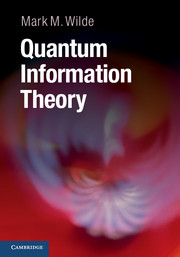Book contents
- Frontmatter
- Contents
- How To Use This Book
- Acknowledgments
- Part I Introduction
- Part II The Quantum Theory
- Part III Unit Quantum Protocols
- 6 Three Unit Quantum Protocols
- 7 Coherent Protocols
- 8 The Unit Resource Capacity Region
- Part IV Tools of Quantum Shannon Theory
- Part V Noiseless Quantum Shannon Theory
- Part VI Noisy Quantum Shannon Theory
- Appendix A Miscellaneous Mathematics
- Appendix B Monotonicity of Quantum Relative Entropy
- References
- Index
6 - Three Unit Quantum Protocols
from Part III - Unit Quantum Protocols
Published online by Cambridge University Press: 05 May 2013
- Frontmatter
- Contents
- How To Use This Book
- Acknowledgments
- Part I Introduction
- Part II The Quantum Theory
- Part III Unit Quantum Protocols
- 6 Three Unit Quantum Protocols
- 7 Coherent Protocols
- 8 The Unit Resource Capacity Region
- Part IV Tools of Quantum Shannon Theory
- Part V Noiseless Quantum Shannon Theory
- Part VI Noisy Quantum Shannon Theory
- Appendix A Miscellaneous Mathematics
- Appendix B Monotonicity of Quantum Relative Entropy
- References
- Index
Summary
This chapter begins our first exciting application of the postulates of the quantum theory to quantum communication. We study the fundamental, unit quantum communication protocols. These protocols involve a single sender, whom we name Alice, and a single receiver, whom we name Bob. The protocols are ideal and noiseless because we assume that Alice and Bob can exploit perfect classical communication, perfect quantum communication, and perfect entanglement. At the end of this chapter, we suggest how to incorporate imperfections into these protocols for later study.
Alice and Bob may wish to perform one of several quantum information-processing tasks, such as the transmission of classical information, quantum information, or entanglement. Several fundamental protocols make use of these resources:
1. We will see that noiseless entanglement is an important resource in quantum Shannon theory because it enables Alice and Bob to perform other protocols that are not possible with classical resources only. We will present a simple, idealized protocol for generating entanglement, named entanglement distribution.
2. Alice may wish to communicate classical information to Bob. A trivial method, named elementary coding, is a simple way for doing so and we discuss it briefly.
3. A more interesting technique for transmitting classical information is superdense coding. It exploits a noiseless qubit channel and shared entanglement to transmit more classical information than would be possible with a noiseless qubit channel alone.
[…]
- Type
- Chapter
- Information
- Quantum Information Theory , pp. 159 - 180Publisher: Cambridge University PressPrint publication year: 2013

